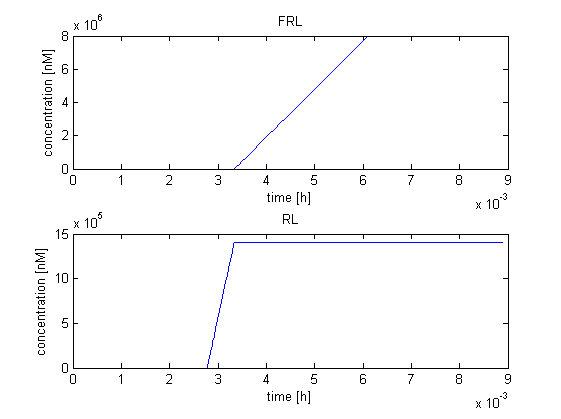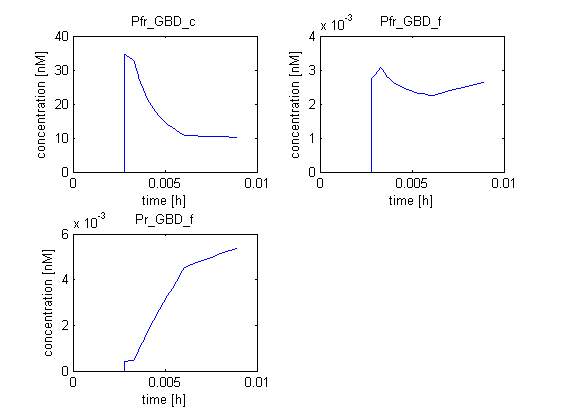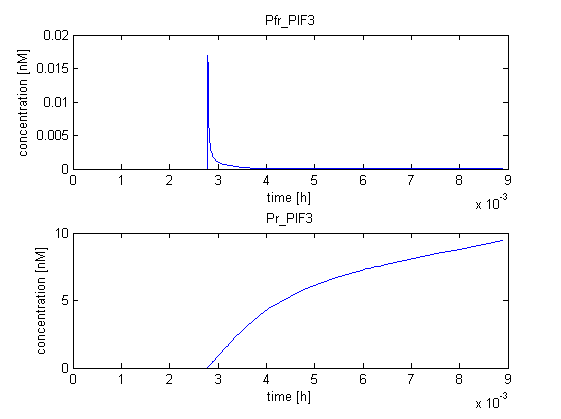Team:ETHZ Basel/Modeling/Light Switch
From 2010.igem.org
Modeling of the relocation of the proteins by red and far-red light
We relocate one of the Che proteins by fusing it either to PhyB or to PIF3. To model the relocation, we decided to try different approaches. One is based on the model recently published by Sorokina et al [1]. As a first step we reimplemented the model as published in the data.
General remarks on the model of Sorokina et al
In [1] Sorokina et al developed (in vivo) and modeled (in silico) the reversible activation of different phytochromes by red and their deactivation by far red light in yeast. Their main model is based on the proteins PhyA and FHL, which have similar properties as PhyB and PIF3 used in our system. In their system PhyA is fused to the Gal4 bindig domain (GBD) and FHL to the Gal4 transcriptional activator domain. Upon activation with red light, both chimeric proteins bind to each other and the complex can activate the transcription of a lacZ reporter which is under the control of a GAL4-responsive artificial promoter. Upon deactivation with far-red light, the complex dissociates and transcription of the lacZ gene is significantly reduced.
In the model Sorokina et al assume that the PhyA protein sequesteres and that only free PhyA can interact with FHL. They state that this interaction is necessary to explain their measurement data, consisting of the strength of fluorescence induced by lacZ ofer time for different experimental settings. Please remark that this signal changes with time constant in the range of hours.
Implementation
One of the models of the system by Sorokina et al [1] is available in the SBML format ([1]). We exported the model to Matlab using the SBToolbox2 ([2]). As a first step we tried to reproduce the data presented in the article [1]. However, this task was not trivial since, although the model is available in the SBML format, necessary parameters are missing. The model as downloaded can only reproduce qualitatively the data for the system kept in the dark. The parameters necessary to define the light input signals were missing.
We tried to reverse engineer these parameters from the information given in the paper. However, we had to recognize that the model available in SBML was slightly different from the model as described in the article: Different to the model in the article, it is not possible to set the strength of the red and far-red light signals directly, but one has to set their derivatives. We believe that this modeling decision might be made to circumvent the problem that some integrators fail to solve a system of differential equations correctly when facing a too high step change in one of the derivatives. To test the model, we removed this work-around and simply not changed the the light inputs by steps, but by ramps with a length of 1s, which is significant smaller than the other time constants being relevant for this part of the model. When we then tried to reproduce the data in the paper, we recognized that we had to reduce the strengths of the light signals approximately by 40 fold. Since we do not know how exactly the inputs were set in the original simulations, we could not deduce the reason for this necessary change in the parameters of the model.
Furthermore several other parameters were not available. These parameters were mainly needed to calculate the fluorescence signal strength from the lucZ concentration.
Goals
- Implement original model
- Plot Figure 6a & 7a from [1] - OK
- Adapt model to experimental setup - OK
- Link model to chemotaxis ODE models
Status
Please find the current version on the SVN-Server.
- (7/25): (SVN rev. 3) start development by George
- (7/27): (SVN rev. 4) original model partly implemented, not yet working (Goal 1.1)
- (7/28): (SVN rev. 5) original model partly implemented, so far working: Goal 1.1 reached
- (7/31): (SVN rev. 6) first attempts to set light-conditions according to experimental setups (Goal 2)
- (8/03): (SVN rev. 7) simplifications, control of all equations and parameters (Goal 2)
- (8/07): (SVN rev. 8) first try to connect light-switch to chemotaxis model (Goal 3)
- (8/10): (SVN rev. 10) goal 2 reached (Goal 2)
Tasks
- Verification & Discussion
I will continue to work on this model the whole week. If you would like to help, please check the SVN server for the current version and send me an email regarding your participation.
Results
Goal 1
The original model was partly implemented and corresponding qualitative plots 6a and 7a have been computed.
Goal 2
Light conditions were set according to first thoughts in Spiro and Mello models. Now it works!
Goal 3
This will be done in the next few days.
 "
"








